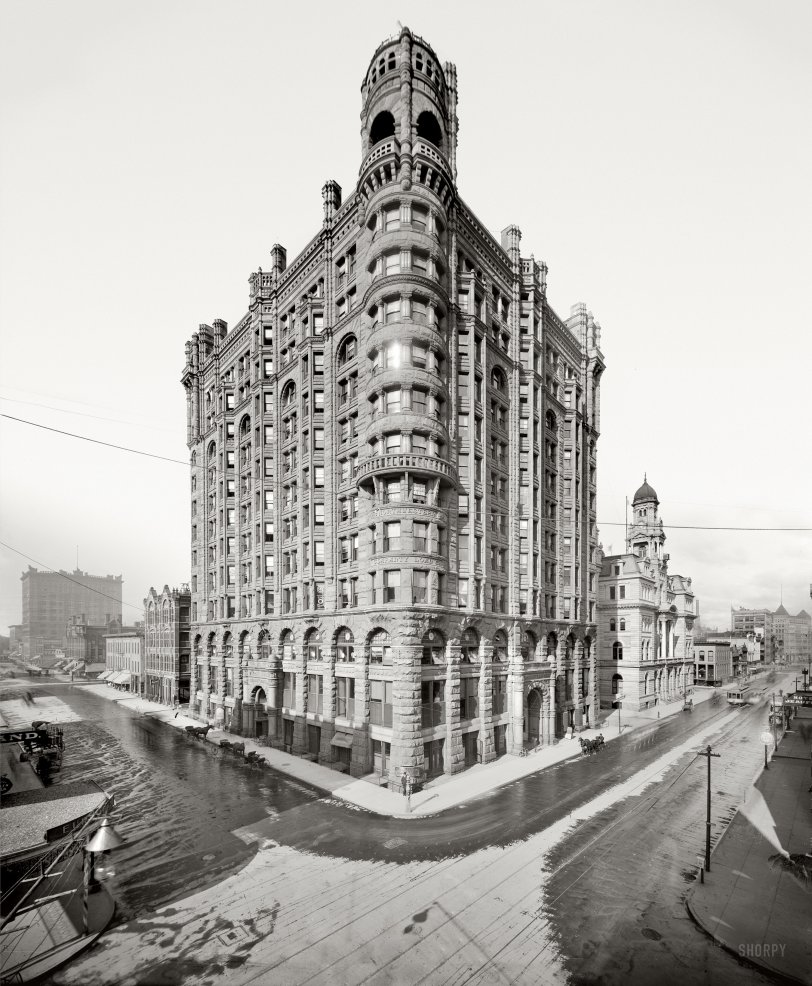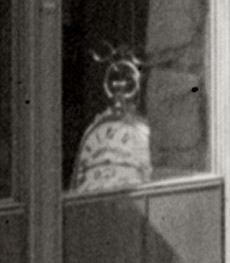


Framed or unframed, desk size to sofa size, printed by us in Arizona and Alabama since 2007. Explore now.
Shorpy is funded by you. Patreon contributors get an ad-free experience.
Learn more.

- Baldwin 62303
- Baldwin VO-1000
- Cold
- No expense spared
- Tough Guys
- Lost in Toyland
- And without gloves
- If I were a blindfolded time traveler
- Smoke Consumer Also Cooks
- Oh that stove!
- Possibly still there?
- What?!?
- $100 Reward
- Freeze Frame
- Texas Flyer wanted
- Just a Year Too Soon
- WWII -- Replacing men with women at the railroad crossing.
- Yes, Icing
- You kids drive me nuts!
- NOT An Easy Job
- I wonder
- Just add window boxes
- Icing Platform?
- Indiana Harbor Belt abides
- Freezing haze
- Corrections (for those who care)
- C&NW at Nelson
- Fallen Flags
- A dangerous job made worse
- Water Stop
Print Emporium
Guaranty Loan: 1905

Minneapolis, Minnesota, circa 1905. "Northwestern Guaranty Loan Building." Note the newfangled "horseless carriage" parked at the curb. 8x10 inch dry plate glass negative, Detroit Publishing Company. View full size.
Pieces of this building survived!
Looks like the stones from this building have been sitting unnoticed in a gravel yard since the demolition. Now some of them may be reclaimed and preserved.
Actually was in the building
I was actually in that building and remember it.
It was gothic to say the least. The noisy, caged elevators, dark though sunlit interior. It belonged in a movie set, but as a building fit to be in? Not so much.
It was a museum piece and no one wanted it. Not so much an issue of regret, but cities need to renew themselves or they become unfit to live in.
All the modern energy codes would have made that firetrap impossible to heat and light.
If such buildings are so great, then why is no one building one like it today with today's codes?
Mysterious figure in window
There is a mysterious looking figure of some kind just above the man standing in front of the building. Just above him to the right in the upper right quadrant of a window on the second floor. Is this figure a person?
[The guy with the round face and thin hands? - Dave]

Arguing two different points
It is easy to declare the "crime" of tearing down a building. I have done it here myself in the past. (See my comments on Boston's old North Station.)
The crime is not tearing down the attractive building. The real crime is the disaster that replaces it.
Even if you discount the "modern" building design of the glass box replacements that you frequently see, you still have many buildings that have no relationship to the pedestrian or the street. The idea of a building that presents (virtually) nothing to the pedestrian level other than a parking garage entrance is the crime.
I love the look of the older buildings, but I hate the look (and functionality) of the newer ones more.
It Seems Unfair
Architecture is the only art form that has to constantly justify its existence.
Old buildings
My family was in commercial real estate for many years. Old buildings like this are appealing from an emotional and sentimental point of view, but not much else.
First you have safety, insurance and liability issues. As these elaborate stone facades age, the various projecting cornices and gargoyles tend to loosen and fall off. Bad for whatever car or pedestrian they happen to land on. Your typical hundred-year-old building might have 20 layers of lead paint and tons of asbestos that need to be removed. This can easily take two or three years and cost millions. During which time there is no money coming in from the space being abated. An office or apartment building is a business concern that needs a steady stream of income.
Then there are structural and finance issues. Buildings constructed in this era, before artificial illumination and forced ventilation were in wide use, tend to have a lot of air shafts, skylights and atriums. Which are expensive to maintain and cut way down on the amount of rentable square footage relative to the building's footprint. Most commercial tenants want "open floors" -- football field-like expanses with no partitions or other obstructions that they can customise to their needs. They also want big windows or glass walls to get lots of natural light. Whereas old buildings offer just the opposite -- the space is broken up by atriums and airshafts, and the peripheral windows are small, like you'd find in a house. So you are left with a bunch of smallish dim rooms that might be suitable for lawyers or doctors but not much else. Conversion to residential use would be a very expensive proposition. If the interior walls are structural, as they are in many old buildings, they can't be removed and you are even worse off.
If you want to finance the renovation with a bond issue maturing in the usual 30 or 50 (or even 100) years, you are running up against the expected 200-year lifespan for the steel framing that holds up most tall buildings. Not many underwriters would take on such a project.
So, as noted below, it is generally cheaper (and much faster) to tear down and put up a new building. Unless of course the taxpayers are willing to foot the bill for tax abatements and rental subsidies. When it comes time for John Q. Public to put his money where his mouth is, he usually takes one look at his property tax bill and says no way.
Firetraps
Minnie A is partly correct ref urban renewal projects. A big reason these gothic structures don't exist today is because from the late 40s on, the US started taking fire codes seriously. There were a series of extremely costly and fatal fires throughout the US in the 40s and 50s (eg - the Our Lady of Angels fre in Chicago in 1958) that highlighted the need for sprinkler systems and modern fire control measures in public buildings. When these codes were put in place, it was cost prohibitive for most of these old 1890s/gothic buildings to retrofit in order to comply with the new fire regulations.
Beautiful buildings. However, most built with zero safety standards in mind. It was cheaper to tear them down than to make them safe.
Curved Dash Olds!
The Olds curved dash runabout was produced 1901 -1907. Somebody had $650 to spend. Four horsepower. Way to go, Ransom E.. Got you're driving goggles?
Re: Urban renewal
What Wikipedia fails to mention is that the building was in receivership when it was condemned -- its owners had declared bankruptcy. Perhaps not surprising for two reasons: It was really old (71 years -- to upgrade it and keep it properly maintained would have cost a fortune, even back then), and by 1961 it was in the "wrong part of town" -- all the high-paying tenants had moved elsewhere. Which was why the building was operating at a loss, something no landlord can afford to do for long. Of course the city could have taken it over, but for what? Buildings don't restore themselves -- it would have taken millions in taxpayer dollars, and even then, who in that part of town could afford to pay the rent?
All the people who declare "it's a crime" when some old gothic white elephant is torn down seem to be forgetting that most office buildings are privately owned, and the owners need to show a profit after they pay their property taxes. Most of the old circa 1900 structures that were demolished in the 1950s and 60s as part of urban renewal projects had similar stories -- operating at a loss in downtowns that had been abandoned by Class A tenants. In commercial real estate, mortgages and lease commitments are measured not in years but decades. If you cannot reasonably project a profit in that kind of time frame, you can't get backing for improvements or renovations.
Nowadays it's different. Most of our downtowns are in much better shape, and developers are able to raise the $50 million or more that it takes to rehab a big building. (Or at least they could up until a few years ago). You have to look at it in the context of the times.
Urban renewal
According to Wikipedia, this beautiful old building was at Third Street and Second Avenue South. Below is the building that's there now.
I've driven by it hundreds of times and hated it each time. Now, I'll hate it that much more.
Not Much Electricity
I like the way the utility poles are holding up only one wire or cable. But with room for expansion, they're thinking ahead. Trolley car seems to have a mast but nothing to connect to. Well it won't be long before the tangle of wires is an eyesore.
[Look carefully and you'll see the trolley wire above the street. - Dave]
Like a Rock
If the architects in charge of designing a building for the Guaranty Loan Building set out to produce an edifice that represented strength, solid foundations, and the eternal endurance of the Rock of Gibraltar, I can only say, "mission accomplished."
Wilburrr!
No wonder the asphalt is hosed down. If I saw this thing looming up ahead, I'd poop in the street too.
Torn down in 1961
http://en.wikipedia.org/wiki/Metropolitan_Building
"There was little practical reason to tear down the building. Records from the day indicate that it was safe and almost fully occupied at the time it was condemned. The structure came down because it was in the wrong neighborhood—on the edge of the so-called Gateway District, sitting on the southwest corner of Third Street South and Second Avenue South."
Watch
Ok, first I saw the giant watch peeking through the first floor corner window but then I thought that it might just be a reflection from across the street so I looked right -- and there it was, a great big open-face pocket watch. But where does it hang from then? (It does look like it stands on the pole, but that's not consistent with the reflection. Any ideas?
[It's on a pole. Not sure why you'd think that's "not consistent" with the reflection. - Dave]
The Penn Station of Minneapolis
This building - known to most Minneapolitans as the Metropolitan Building - was demolished in a fit of areawide urban renewal known as the Gateway Area project. As recounted in Larry Millet's "Lost Twin Cities" (which has before-and-after pictures of the building on its front and back covers), the day before its demolition began, Wally Marotzke, who was for twenty years the building's engineer, stated to a reporter, "I'll tell you one thing: the future generations are going to read about this building and they'll see some of the buildings they're putting up here and they'll damn us, they will, for tearing down the Met." That was an understatement.
























On Shorpy:
Today’s Top 5